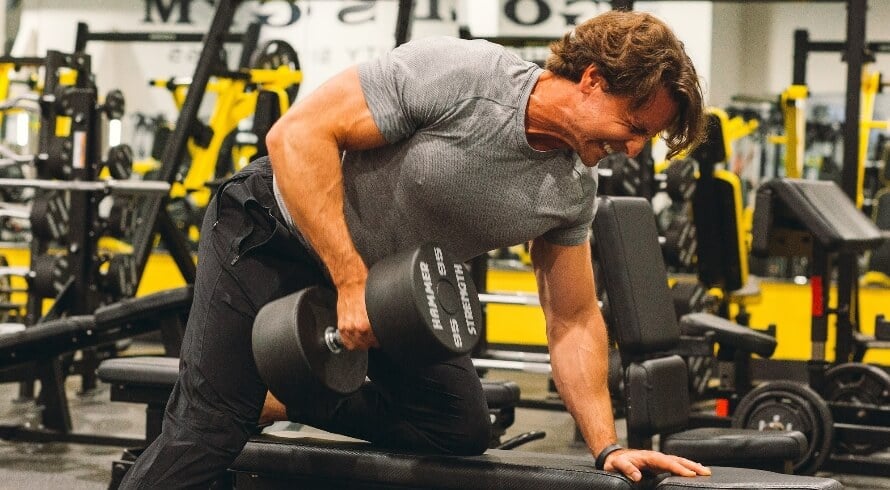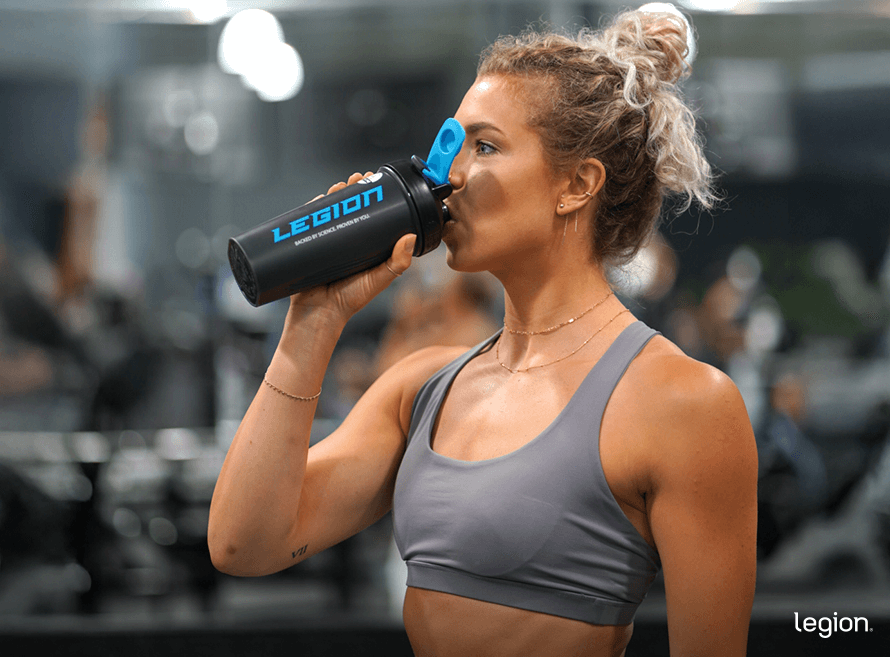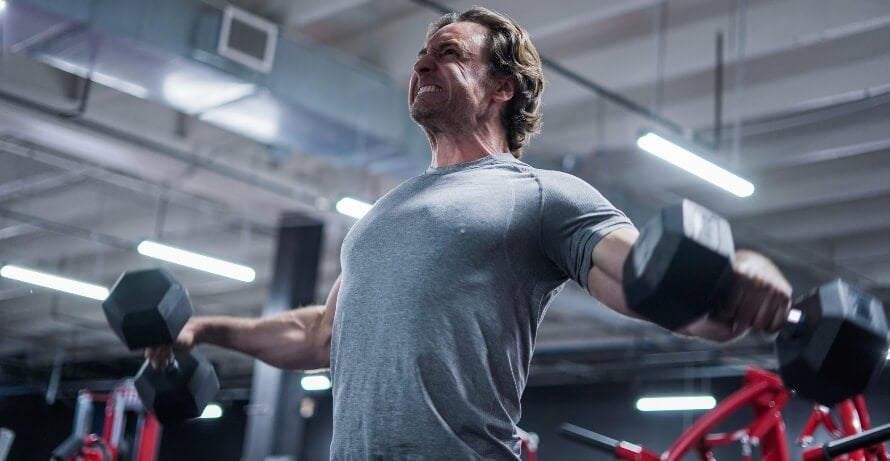Wondering what helps sore muscles after a workout? Whether you’re hurting from your first squat session or sore from a new bench press PR, this guide breaks down what causes soreness and what actually helps you recover.
What helps sore muscles after a workout isn’t cold plunges, compression clothing, or cryo chambers—it’s the boring stuff: staying active, eating protein, taking creatine, and getting enough sleep.
Massage might help, too—at least when it comes to easing discomfort.
In this article, you’ll learn why you’re so sore after working out, how to reduce it according to research, and how long it usually takes to get back to full strength.
Key Takeaways
- Muscle soreness mostly comes from tiny muscle tears and inflammation caused by unfamiliar or intense training—not lactic acid. You’re also more likely to get sore after exercises that stretch your muscles under load.
- Of all the recovery tools people use, massage is the most effective at easing soreness, but it doesn’t help you regain your strength any faster.
- What really helps sore muscles after a workout is staying lightly active, eating enough protein, taking creatine, and getting plenty of sleep.
- For help hitting your daily protein target, consider taking a high-quality protein powder like Legion’s Whey+ or Casein+. And for a pure and potent source of creatine, try Legion’s micronized creatine monohydrate, creatine gummies or capsules, or post-workout Recharge
- Most soreness peaks 24-to-48 hours after training and fades within 3-to-5 days. During this time, you can train if the soreness is mild, but it’s better to rest if it’s severe.
Why Am I So Sore After Working Out?

The muscle soreness you feel after a workout mostly comes from the tiny tears you create in your muscles while lifting weights.
It’s usually worse when you try an unfamiliar exercise or perform an exercise that deeply stretches your muscles while under load. For instance, your glutes and hamstrings will likely feel more tender after Romanian deadlifts than hip thrusts because RDLs stretch these muscles more.
When you cause these microscopic tears, your body responds by sending blood, fluid, and immune cells to start repairing the tissue. This buildup creates inflammation, which causes the stiffness, tenderness, and aching you feel a day or two later.
Does Lactic Acid Cause Muscle Soreness After a Workout?
No—lactic acid has nothing to do with post-workout muscle soreness. Research shows that your body clears any lactic acid from your muscles within an hour of finishing your workout.
What Helps Sore Muscles After a Workout?

The best ways to help sore muscles after a workout are to stay lightly active, eat enough protein, take creatine, sleep at least seven hours per night, and, if possible, get a massage.
Of all these options, massage is probably the one most commonly associated with recovery—and research shows it’s likely justified.
A huge systematic review and meta-analysis of 99 studies published in Frontiers in Physiology found that of all the tools people turn to for recovery, massage was the most effective.
It outperformed everything else—including ice baths, hyperbaric therapy, electrostimulation, cryotherapy, and stretching—when it came to reducing pain, fatigue, and markers of inflammation.
That said, it’s not perfect.
For one, getting a massage after every training session isn’t practical (or affordable) for most people.
And more importantly, other research shows that while massage (and ice baths, incidentally) can help you feel better, they don’t actually restore strength or performance any quicker.
And for a recovery method to be truly effective, it shouldn’t just ease post-workout soreness—it should help you bounce back stronger, sooner.
That’s why the basics are probably still the most effective ways to help sore muscles.
For instance, research (including the meta-analysis from earlier) shows that staying lightly active in the days following a punishing workout is a good way to accelerate recovery. For example, you could go for a light walk the day after leg day.
Likewise, research shows that eating enough protein and taking creatine supplements also ease sore muscles and help you recover your strength faster.
If you want a delicious and convenient source of high-quality protein, try Legion’s Whey+ or Casein+ protein powders. Or, for a pure and potent source of creatine monohydrate, try Legion’s micronized creatine monohydrate, creatine gummies or capsules, or post-workout Recharge.
Don’t overlook sleep, either.
Studies show that getting fewer than 7 hours a night hinders muscle growth, ramps up muscle breakdown, and slows muscle repair by reducing muscle protein synthesis. In other words, it blunts your body’s ability to rebuild and recover.
How Long Should I Be Sore After a Workout?
Most people feel sore for 3-to-5 days after a hard workout.
The ache usually begins 12-to-24 hours after training, peaks between 24 and 48 hours, and then fades over the next couple of days.
Should I Work Out with Sore Muscles?

If your muscles are only mildly sore, you can probably train. If you’re hobbling up stairs or unable to lift your own arms, it’s better to skip it.
Soreness means your muscles are still repairing, but that doesn’t automatically mean you should stay home. The real question is how sore you are—and how much it affects your performance.
If you’re so sore you can’t move without wincing, chances are your strength and flexibility will be compromised—so it’s probably not worth training through.
But if the soreness is mild, it might not matter much. Many gymgoers think they’re too sore to train, only to find that once they’re warmed up and handling heavier weights, they forget it’s even there.
FAQ #1: How do you reduce muscle soreness after a workout?
The best ways to reduce muscle soreness after a workout are the basics—stay lightly active in the following days, eat enough protein, take creatine, and get at least seven hours of sleep per night. A massage can also help if it’s feasible.
FAQ #2: My legs are so sore from squats I can’t walk. What should I do?
If your legs are so sore from squats you can’t walk properly, skip any intense lower-body training for a few days. In the meantime, stay lightly active, eat enough protein, take creatine, and prioritize sleep. If it’s practical, getting a massage might help, too.
FAQ #3: Why don’t I feel sore after working out?
Soreness just means you did something your body isn’t used to—like a new exercise or a lot more volume (sets) than usual. It’s not a reliable marker of a good workout or future gains.
In fact, if you train consistently, your muscles adapt and get better at handling stress. This is called the repeated bout effect, and it protects your muscles from future soreness—even if you’re still training hard.
So if you don’t feel sore after working out, don’t sweat it. Your muscles are adapting, and you’re still making progress.
Scientific References +
- Wiecha, Szczepan, et al. “Physical Therapies for Delayed Onset Muscle Soreness: A Protocol for an Umbrella and Mapping Systematic Review with Meta-Meta-Analysis.” Journal of Clinical Medicine, vol. 13, no. 7, 29 Mar. 2024, p. 2006, www.ncbi.nlm.nih.gov/pmc/articles/PMC11012564/, https://doi.org/10.3390/jcm13072006.
- Proske, U., and D. L. Morgan. “Muscle Damage from Eccentric Exercise: Mechanism, Mechanical Signs, Adaptation and Clinical Applications.” The Journal of Physiology, vol. 537, no. 2, Dec. 2001, pp. 333–345.
- Cheung, Karoline, et al. “Delayed Onset Muscle Soreness.” Sports Medicine, vol. 33, no. 2, 23 Oct. 2012, pp. 145–164, pubmed.ncbi.nlm.nih.gov/12617692/, https://doi.org/10.2165/00007256-200333020-00005.
- Gulick, D T, et al. “Various Treatment Techniques on Signs and Symptoms of Delayed Onset Muscle Soreness.” Journal of Athletic Training, vol. 31, no. 2, Apr. 1996, pp. 145–52, pubmed.ncbi.nlm.nih.gov/16558388/.
- Menzies, Paul, et al. “Blood Lactate Clearance during Active Recovery after an Intense Running Bout Depends on the Intensity of the Active Recovery.” Journal of Sports Sciences, vol. 28, no. 9, July 2010, pp. 975–982, www.tandfonline.com/doi/full/10.1080/02640414.2010.481721, https://doi.org/10.1080/02640414.2010.481721.
- Dupuy, Olivier, et al. “An Evidence-Based Approach for Choosing Post-Exercise Recovery Techniques to Reduce Markers of Muscle Damage, Soreness, Fatigue, and Inflammation: A Systematic Review with Meta-Analysis.” Frontiers in Physiology, vol. 9, no. 403, 26 Apr. 2018, https://doi.org/10.3389/fphys.2018.00403.
- Angelopoulos, Pavlos, et al. “Cold-Water Immersion and Sports Massage Can Improve Pain Sensation but Not Functionality in Athletes with Delayed Onset Muscle Soreness.” Healthcare, vol. 10, no. 12, 5 Dec. 2022, p. 2449, https://doi.org/10.3390/healthcare10122449.
- Rodden, Jaime, et al. “Sitting Less, Recovering Faster: Investigating the Relationship between Daily Sitting Time and Muscle Recovery Following Intense Exercise: A Pilot Study.” Journal of Functional Morphology and Kinesiology, vol. 9, no. 1, 29 Jan. 2024, pp. 24–24, https://doi.org/10.3390/jfmk9010024. Accessed 7 Feb. 2024.
- Davies, Robert, et al. “The Effect of Whey Protein Supplementation on the Temporal Recovery of Muscle Function Following Resistance Training: A Systematic Review and Meta-Analysis.” Nutrients, vol. 10, no. 2, 16 Feb. 2018, p. 221, www.mdpi.com/2072-6643/10/2/221, https://doi.org/10.3390/nu10020221.
- Lam, Fui-Ching, et al. “Effectiveness of Whey Protein Supplements on the Serum Levels of Amino Acid, Creatinine Kinase and Myoglobin of Athletes: A Systematic Review and Meta-Analysis.” Systematic Reviews, vol. 8, no. 1, 31 May 2019, https://doi.org/10.1186/s13643-019-1039-z. Accessed 12 Jan. 2020.
- Kreider, Richard B., et al. “International Society of Sports Nutrition Position Stand: Safety and Efficacy of Creatine Supplementation in Exercise, Sport, and Medicine.” Journal of the International Society of Sports Nutrition, vol. 14, no. 1, 13 June 2017, pubmed.ncbi.nlm.nih.gov/28615996/, https://doi.org/10.1186/s12970-017-0173-z.
- Doherty, Rónán, et al. “The Sleep and Recovery Practices of Athletes.” Nutrients, vol. 13, no. 4, 1 Apr. 2021, p. 1330, www.mdpi.com/2072-6643/13/4/1330, https://doi.org/10.3390/nu13041330.
- Vickers, Andrew J. “Time Course of Muscle Soreness Following Different Types of Exercise.” BMC Musculoskeletal Disorders, vol. 2, no. 1, 23 Oct. 2001, https://doi.org/10.1186/1471-2474-2-5.
- Zourdos, Michael C., et al. “Repeated Bout Effect in Muscle-Specific Exercise Variations.” Journal of Strength and Conditioning Research, vol. 29, no. 8, Aug. 2015, pp. 2270–2276, https://doi.org/10.1519/jsc.0000000000000856. Accessed 8 May 2019.
- Clarkson, P. M., et al. “Muscle Function after Exercise-Induced Muscle Damage and Rapid Adaptation.” Medicine and Science in Sports and Exercise, vol. 24, no. 5, 1 May 1992, pp. 512–520, pubmed.ncbi.nlm.nih.gov/1569847/. Accessed 16 Feb. 2022.
- Flann, Kyle L., et al. “Muscle Damage and Muscle Remodeling: No Pain, No Gain?” Journal of Experimental Biology, vol. 214, no. 4, 15 Feb. 2011, pp. 674–679, jeb.biologists.org/content/214/4/674, https://doi.org/10.1242/jeb.050112. Accessed 20 Apr. 2020.
- Chen, Trevor C. “Variability in Muscle Damage after Eccentric Exercise and the Repeated Bout Effect.” Research Quarterly for Exercise and Sport, vol. 77, no. 3, Sept. 2006, pp. 362–371, https://doi.org/10.1080/02701367.2006.10599370. Accessed 8 May 2019.
